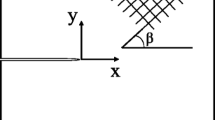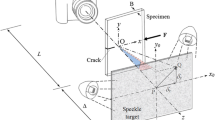Abstract
The feasibility of using Coherent Gradient Sensing (CGS) interferometry for studying the fracture behavior of unidirectional fiber-reinforced composites is investigated in this paper. First, the solution for the deformation field surrounding the tip of a crack in an orthotropic material is summarized. Specifically, the most singular term in the asymptotic expansion is explicitly presented. Then, the quantities that relate to the CGS measurements are derived in terms of the spatial position, stress intensity factors, and material constants. Based on these results, synthetic CGS fringe patterns are plotted numerically, and the effects of material anisotropy and crack-tip mixity on the shape of CGS fringe pattern are investigated. In addition, a finite difference interpretation of CGS fringes caused by the finite spacing of the CGS diffraction gratings is taken into account in the simulation. Finally, the initiation fracture toughness and the subsequent resistance curve behavior of a particular unidirectional graphite/epoxy composite are measured using the CGS method. The optically measured stress intensity factors compare successfully to values obtained from the load measurements and the available analytical solutions.
Similar content being viewed by others
References
Bao, G., Ho, S., Suo, Z. and Fan, B. (1992). The role of material orthotropy in fracture specimens for composites. International Journal of Solids and Structures 29, 1105–1116.
Bruck, H.A. and Rosakis, A.J. (1992). On the sensitivity of Coherent Gradient Sensing: Part I – A theoretical investigation of accuracy in fracture mechanics applications. Optics and Lasers in Engineering 17, 83–101.
Bruck, H.A. and Rosakis, A.J. (1993). On the sensitivity of Coherent Gradient Sensing: Part II – An experimental investigation of accuracy in fracture mechanics applications. Optics and Lasers in Engineering 18, 25–51.
Chai, H. (1990). Interlaminar shear fracture of laminated composites. International Journal of Fracture 43, 117–131.
Davies P. and Benzeggagh M.L. (1989). Interlaminar mode–I fracture testing (Edited by K. Friedrich), Application of Fracture Mechanics to Composite Materials, Elsevier, New York, 81–112.
Hutchinson, J.W. and Suo, Z. (1992). Mixed mode cracking in layered materials (Edited by J.W. Hutchinson and T. Wu), Advances in Applied Mechanics 29, 63–191.
Krishnaswamy, S., Tippur, H.V. and Rosakis, A.J. (1992). Measurement of transient crack tip deformation fields using the method of coherent gradient sensing. Journal of the Mechanics and Physics of Solids 40, 339–372.
Lee, Y.J., Lambros, J. and Rosakis, A.J. (1996). Analysis of Coherent Gradient Sensing (CGS) by Fourier optics. Optics and Lasers in Engineering 25, 25–53.
Lekhnitskii, S.G. (1968). Anisotropic Plates(Translated by S.W. Tsai and T. Cheron), Gordon & Breach Science Publishers, New York.
Liu, C., Huang, Y., Lovato, M.L. and Stout, M.G. (1996). Measurement of the fracture toughness of a fiberreinforced composite using the Brazilian disk sample geometry. Los Alamos National Laboratory Report LA–UR–96–3845, 1996. To appear in the International Journal of Fracture.
Mason, J.J., Lambros, J. and Rosakis, A.J. (1992). The use of a coherent gradient sensor in dynamic mixed–mode fracture mechanics experiments. Journal of the Mechanics and Physics of Solids 40, 641–661.
Muskhelishvili, N.I. (1953). Some Basic Problems in the Mathematical Theory of Elasticity(Translated by J.R.M. Radok), Noordhoff, Groningen, Holland.
Rosakis, A.J. (1993). Two optical techniques sensitive to gradients of optical path difference: The method of caustics and the coherent gradient sensor (CGS) (Edited by J. Epstein), Experimental Techniques in Fracture 3, Chapter 10, 327–425.
Rosakis, A.J. (1994). Private communications.
Rosakis, A.J. and Ravi–Chandar, K. (1986). On crack–tip stress state: An experimental evaluation of threedimensional effects. International Journal of Solids and Structures 22, 121–134.
Sanford, R.J. and Dally, J.W. (1979). A general method for determining mixed–mode stress intensity factors from isochromatic fringe patterns. Engineering Fracture Mechanics 11, 621–633.
Tada, H., Paris, P.C. and Irwin, G.R. (1985). The Stress Analysis of Cracks Handbook. Del Research, St. Louis, MO.
Tippur, H.V. (1992). Coherent gradient sensing: A Fourier optics analysis and applications to fracture. Appl. Optics 31, 4428–4439.
Tippur, H.V., Krishnaswamy, S. and Rosakis, A.J. (1991). A coherent gradient sensor for crack tip measurements: Analysis and experimental results. International Journal of Fracture 48, 193–204.
Yoon S.H. and Hong C.S. (1990). Interlaminar fracture toughness of graphite/epoxy composite under mixed–mode deformations. Experimental Mechanics 30, 234–239.
Author information
Authors and Affiliations
Rights and permissions
About this article
Cite this article
Liu, C., Rosakis, A., Ellis, R. et al. A Study of the Fracture Behavior of Unindirectional Fiber- Reinforced Composite Using Coherent Gradient Sensing (CGS) Interferometry. International Journal of Fracture 90, 355–382 (1998). https://doi.org/10.1023/A:1007479709559
Issue Date:
DOI: https://doi.org/10.1023/A:1007479709559




